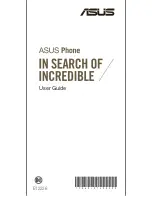
hearing aids and wireless Tablet PCs so that no interference occurs when a person
uses a compatible Tablet PC and a compatible hearing aid at the same time. This
standard was approved by the IEEE in 2000.
FDA continues to monitor the use of wireless Tablet PCs for possible interactions
with other medical devices. Should harmful interference be found to occur, FDA will
conduct testing to assess the interference and work to resolve the problem.
Additional information on the safety of RF exposures from various sources can be
obtained from the following organizations:
FCC RF Safety Program:
http://www.fcc.gov/oet/rfsafety/
Environmental Protection Agency (EPA):
http://www.epa.gov/radiation/
Occupational Safety and Health Administration's (OSHA):
http://www.osha.gov/SLTC/radiofrequencyradiation/index.html
National institute for Occupational Safety and Health (NIOSH):
http://www.cdc.gov/niosh/
World health Organization (WHO):
http://www.who.int/peh-emf/
International Commission on Non-Ionizing Radiation Protection:
http://www.icnirp.de
National Radiation Protection Board (UK):
http://www.hpa-radiationservices.org.uk/rpa
Updated 4/3/2002: US food and Drug Administration
http://www.fda.gov/Radiation-
EmittingProducts/RadiationEmittingProductsandProcedures/HomeBusinessandEntertainment/
CellTablet PCs/default.htm
Road Safety
Your wireless Tablet PC gives you the powerful ability to communicate by voice,
almost anywhere, anytime. But an important responsibility accompanies the benefits
of wireless Tablet PCs, one that every user must uphold.
When driving a car, driving is your first responsibility. When using your wireless
Tablet PC behind the wheel of a car, practice good common sense and remember
the following tips:
1. Get to know your wireless Tablet PC and its features, such as speed dial and
redial. If available, these features help you to place your call without taking
your attention off the road.
2. When available, use a hands-free device. If possible, add an additional layer
of convenience and safety to your wireless Tablet PC with one of the many
hands free accessories available today.
3. Position your wireless Tablet PC within easy reach. Be able to access your
wireless Tablet PC without removing your eyes from the road. If you get an
incoming call at an inconvenient time, let your voice mail answer it for you.
4. Let the person you are speaking with know you are driving; if necessary,
suspend the call in heavy traffic or hazardous weather conditions. Rain, sleet,
snow, ice and even heavy traffic can be hazardous.
5. Do not take notes or look up Tablet PC numbers while driving. Jotting down a
“to do” list or flipping through your address book takes attention away from













































